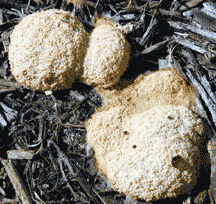|
|||||||||||
|
|||||||||||
Keep Slime Mold Out of Your GardenDog vomit slime mold looks and smells like its name, and it thrives on un-composted wood and too much mulchSome time during July and August, don’t be surprised if you find dog vomit on the ground of your garden, especially if you’ve mulched with colored wood chip mulch, double-shredded hardwood bark mulch or fresh woodchips. Dog vomit is a slime mold that grows readily on un-composted wood mulches, thriving in dark damp areas under shrubs or in dense mulch. It likes warm, damp, high-organic substrates and un-composted wood waste. This slime mold grows rapidly, forming a bubbly mound of white to pink globs in tight clusters. Within hours, it turns yellowish; within a few days it turns brown. It also has a bad odor resembling dog vomit. Two conditions fuel the growth of dog-vomit mold. One: Allowing thick layers of mulch to accumulate, especially when topped with a fresh layer of uncomposted wood waste. Two: Frequent light waterin There are no chemicals that will prevent dog vomit mold from occurring, and no chemicals can kill it once it has become established. The only eradication method is scooping it up and discarding it in the compost pile or sweeping it away with a broom. After you have removed it, irrigate only when necessary. One good soaking at seven- to 10-day intervals is best. In the future, use only well-composted mulch or pine bark mulch. Be sure to remove the old mulch before applying the new. The total amount of mulch under and around ornamental plants should not exceed two inches. If you mulch with compost, you will not see or smell dog vomit in your landscape. Removing Stilt Grass Takes Chemicals and PersistenceQ My lawn has become invested with Japanese stilt grass. The forest surrounding my small lawn area is also infested with this villain. Attempts at pulling it up do control it for the season in localized areas, but it returns the next season, and in large areas, this is an insurmountable task. Is there a magic bullet to get rid of this unwelcome intruder? —Charlie Conklin, via email A Japanese stilt grass produces an abundance of seeds. It can be controlled only by using two chemicals. Controlling the adult grass with Roundup is only one control method. Then you must kill the seeds as they germinate by spreading a pre-emergent herbicide like Preen granules (as described on the label) on the soil and watering it in immediately. Since the seeds can remain dormant in the soil for several years, you will need to repeat the Preen treatment every six weeks starting just about at the time forsythia starts dropping its flower petals. Last application of Preen will be early August if you want to reseed with native grasses in mid September. Ask Dr. Gouin your questions at [email protected]. All questions will appear in Bay Weekly. Please include your name and address. |
|||||||||||
|
|||||||||||
|
|
|||||||||||
|
© COPYRIGHT 2007 by New Bay Enterprises, Inc. All rights reserved.
|
|||||||||||


 g of heavily mulched landscape plantings.
g of heavily mulched landscape plantings.